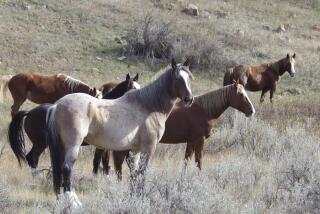Herd of Wild Horses Eating Away at Refugee’s Fragile Ecosystem : Seashore: Their munching deprives birds of vital hiding places and weakens protective sand dunes. Delicate vegetation and birds’ eggs are trampled.
- Share via
ASSATEAGUE ISLAND, Md. — Tourists are fascinated by them, children dream of them, but science is painting a less romantic portrait of the wild horses that roam the national seashore here.
The growing herd is killing the natural beach environment, scientists say. The animals munch marsh grass, depriving birds of vital hiding places. They chew up beach plants, weakening sand dunes that protect the island. They trample delicate vegetation and, sometimes, birds’ eggs.
With concern increasing over the horses’ effect on the island, Assateague Island National Seashore is testing a contraceptive injection that may be used to reduce the size of its herd. It has grown from fewer than 20 horses in the 1960s to about 160 today.
At nearby Chincoteague National Wildlife Refuge in Virginia, where the local volunteer fire department owns a herd of 150 adult horses, officials have begun monitoring for environmental damage.
Removing the horses is not an option, officials say: They are a much-loved symbol of the islands and are a tourist attraction that boosts the local economy. But at the urging of federal scientists and environmental groups, park officials are implementing plans to try to counter the problems the horses cause.
“Assateague and horses go together,” said Carl S. Zimmerman, an official of the National Park Service, which runs the seashore. “On the other hand, the Park Service mission is to preserve the natural environment, and the horses are having an adverse impact. So it’s up to us to find a balance.”
There have been horses since Colonial days on Assateague Island. Books such as the popular children’s story “Misty of Chincoteague” promote the idea that the horses came ashore after a Spanish galleon was shipwrecked, but most historians think that farmers brought them to the islands to evade taxes and grazing limits on the mainland.
It’s unclear why the horse population has ballooned in recent years on the national seashore. Park Service officials have been trying to find a way to control that herd; six years ago they began testing a contraceptive made from pig ova protein.
The contraceptive has a temporary effect, is 95% effective, can be injected by dart gun and does not change animal behavior, said Jay Kirkpatrick, the Montana researcher supervising the experiment. Animal-rights groups helped pay for the research.
Seashore officials hope the contraceptive will be the centerpiece of a population-control program to be implemented in the spring.
To demonstrate the horses’ effect on the island, Zimmerman stood on a patch of marsh grass, called spartina, at the national seashore’s northern tip, far from the beach where most tourists spend their time. Three horses grazed nearby, paying no attention. The crunchy green stems reached Zimmerman’s ankles.
“It should be up to here,” he said, pointing to his knees. “Where is a bird going to nest here?”
In the cropped spartina, the population of rails, a secretive marsh bird that hides in tall grass, has declined. Decaying spartina creates nourishment for fish and other species, so the horses’ grazing takes food from others. And when spartina fades, other less desirable plants flourish, transforming the character of the marsh.
The horses also love dune grass--so much so that a wire fence recently was installed around two miles of dunes to protect 500,000 stems of grass that volunteers planted in the winter.
The dunes not only shield the beach from storm surges, but they also provide a buffer from salt and wind for the wetland plants that spring up behind the beach. The wetlands are home to birds, foxes, raccoons, reptiles, frogs, turtles and other creatures.
Assateague is not alone in its problems with wild horses. Similar horse damage on Cumberland Island in Georgia and at Cape Lookout National Seashore in North Carolina has the National Park Service preparing to begin a three-year program in the fall to implement population-control plans there as well. Officials favor the contraceptive, but say that everything from selling some horses to removing all of them will be considered.
“Just common sense would dictate that the herd cannot (be allowed to) increase until it eats itself out of a food supply,” said Bruce Rodgers, resource-management specialist with the Park Service’s regional office in Atlanta. “Before that, there would be tremendous damage to the ecosystem.”
Damage from horses appears to be lighter in the Chincoteague Wildlife Refuge, which is on the south end of Assateague Island and is run by the U.S. Fish and Wildlife Service. There, 150 horses are fenced off from most of the land.
Without fencing, “you would have the entire habitat of this refuge destroyed within five years,” said refuge manager John D. Schroer. The refuge is home to endangered piping plovers, migrating shorebirds, deer, rabbits and a variety of other animals.
On Chincoteague, the horses also are a big draw. Thousands of tourists come each July for the annual swim of horses from the island to the mainland. The swim is run by the fire department, which sells the colts to keep the herd size down. This year, 87 were sold for an average price of $500 to $700.
More to Read
Sign up for Essential California
The most important California stories and recommendations in your inbox every morning.
You may occasionally receive promotional content from the Los Angeles Times.













